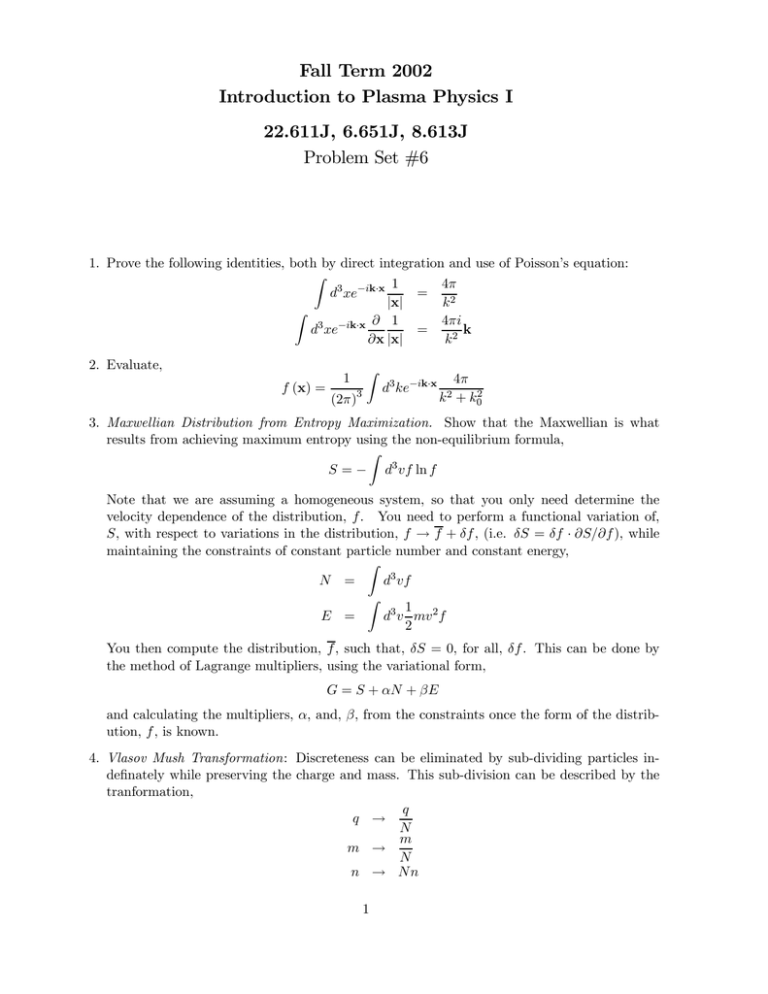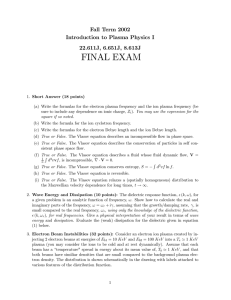Document 13608218
advertisement

Fall Term 2002 Introduction to Plasma Physics I 22.611J, 6.651J, 8.613J Problem Set #6 1. Prove the following identities, both by direct integration and use of Poisson’s equation: Z 4π 1 d3 xe−ik·x = |x| k2 Z 4πi ∂ 1 = d3 xe−ik·x k ∂x |x| k2 2. Evaluate, 1 f (x) = (2π )3 Z d3 ke−ik·x k2 4π + k02 3. Maxwellian Distribution from Entropy Maximization. Show that the Maxwellian is what results from achieving maximum entropy using the non-equilibrium formula, Z S = − d3 vf ln f Note that we are assuming a homogeneous system, so that you only need determine the velocity dependence of the distribution, f . You need to perform a functional variation of, S, with respect to variations in the distribution, f → f + δf , (i.e. δS = δf · ∂S/∂f ), while maintaining the constraints of constant particle number and constant energy, Z N = d3 vf Z 1 E = d3 v mv 2 f 2 You then compute the distribution, f , such that, δS = 0, for all, δf . This can be done by the method of Lagrange multipliers, using the variational form, G = S + αN + βE and calculating the multipliers, α, and, β, from the constraints once the form of the distrib ution, f , is known. 4. Vlasov Mush Transformation: Discreteness can be eliminated by sub-dividing particles in definately while preserving the charge and mass. This sub-division can be described by the tranformation, q q → N m m → N n → Nn 1 where, N , is the number of subdivisions, and, q, m, and, n, are particle charge, mass and den sity. Show that the Vlasov equation is invariant under this subdivision, while the discreteness parameter, 1 nλ3D is not. Furthermore show that, 1 =0 N→∞ nλ3 D lim Thereby proving that the Vlasov equation becomes exact in the limit of zero discreteness. 5. Prove the Final Value Theorem for Laplace Transforms. Recall our convention for the trans form and its inverse, Z ∞ dteiωt g (t) gω = 0 Z 1 dωe−iωt gω g (t) = 2π L where, L, denotes the Laplace inversion contour residing above all singularities of, gω . (In other words, gω , is analytic for, Im ω > L). The Final Value Theorem states, lim g (t) = lim (−iωgω ) t→∞ ω→0 This theorem only applies to stable systems, of course. Elaborate on the meaning of “stable” as applied to this system, and indicate any changes in the theorem needed to account for systems that oscillate indefinitely without decay. 2





